 North Carolina Chess Association
North Carolina Chess Association
NCCA officers
Charles Roberson – President
John Timmel – First Vice President
Grant Oen – Scholastic Vice President
Wayne H. Spon – Secretary/Treasurer
North Carolina Gambit – July 2022
This month’s Contributors
Charles Roberson – Editor
Mike Tedder
John Timmel
Web support, edit, and distribution
John Timmel
In this issue, you will find:
Mike Tedder – Visit to the Marshall Chess Club
Charles Roberson – President’s Perspective – Growing The Chess Population
John Timmel – To Move and Win!
We’re looking for contributors to the Gambit!
Submit your games, articles, etc. to the editor Charles Roberson at croberson2@triad.rr.com
____________________________________________________________________________
VISIT TO THE MARSHALL CHESS CLUB
By Mike Tedder
My first major post-Covid trip with my wife Jean was to New York City in June of this year. Earlier in the year, Jean began rehearsals with a choral group that was scheduled to perform in New York’s Carnegie Hall. We planned to do a lot of the New York tourist attractions as a part of our six-night stay. During the first few days, Jean was committed to meetings and rehearsals. That left me with time to explore the city on my own. The first thing on my list was a visit to the Marshall Chess Club.
Only the Mechanics Institute in San Francisco is older than the Marshall CC. The Marshall was formed in 1915 by American Grand Master Frank Marshall. Its original location was at Keene’s Chop House on 32nd Street. Marshall wanted a place where the players of the day could 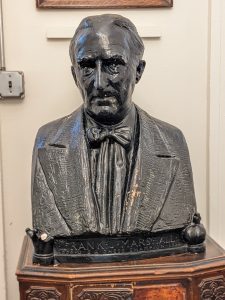 meet, play, and exchange ideas much like the famous chess cafes and coffee houses of London and Paris. It soon became a popular meeting place for New York chess players of all levels. In 1931 a group of patrons purchased a building on 10th Street for a permanent site and donated it to the club.
meet, play, and exchange ideas much like the famous chess cafes and coffee houses of London and Paris. It soon became a popular meeting place for New York chess players of all levels. In 1931 a group of patrons purchased a building on 10th Street for a permanent site and donated it to the club.
The Marshall CC membership rolls, and invited guests, are a Who’s Who of chess. Frank Marshall himself was recognized as the U.S. Champion from 1909 until 1936. Other famous Marshall members from his era include Reuben Fine, Fred Reinfeld, and Arthur Dake. Visiting World Champions Raul Capablanca and Alexander Alekhine dazzled players with exhibitions held inside the club. The most famous member was a kid named Bobby Fischer who took the train in from Brooklyn to play for hours on end. American world class grandmasters holding Marshall CC membership include Fabiano Caruana and Hikrau Nakamura. Current World Champion Magnus Carlsen’s membership application card is on display. Its expiration date is listed as “N/A”.
I found a lot of information on the Marshall CC’s website to help me plan my Saturday morning visit. In addition to almost daily competitions, the Marshall CC hosts lessons, lectures, book signings, and simultaneous exhibitions on a regular basis at the club and online. The club had scheduled a three round G/25 rapid event for U2000 players the morning of my visit. I doubted I would be allowed to participate since the tournament was listed for members only. In fact, the website stated that the club would allow only vaccinated members and no visitors. I hoped this was old information and that I would now be allowed inside.
My Uber driver dropped me off at the Marshall CC’s 10th Street address in the Greenwich Village neighborhood. The street probably looks much like it did in Frank Marshall’s day. Brownstone buildings, trees, and parked cars lined both sides of the street. The only thing that denoted the Marshall’s club site was a simple plaque above its below street level entrance door. I found that one does not just walk into the Marshall CC through this door. The front door was locked. I think members are admitted either by a person stationed at the door or by inputting a code. I rang the call button near the door and waited. A few minutes later, a young man opened the door. I explained that I was a visitor and would like to play in this morning’s event. He explained that the tournament was for members only. I asked to be able to observe the event. Sorry, for members only. I asked to be allowed inside to see the club’s exhibits. Sorry, for members only. Then I played my last card. I explained that I was from North Carolina, would be in town for only a few days, and would like to write an article for our state’s chess newsletter featuring the famous Marshall CC. “OK, you can come in and look around for awhile”, replied the doorkeeper and disappeared up the staircase near the entrance. I decided to take the liberal definition of ‘awhile’.
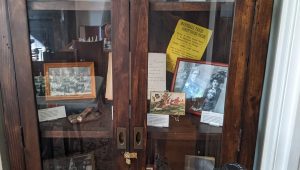
I began to explore the 190-year-old building. The Marshall CC occupies the bottom two floors. Each floor has a long hall with high ceilings, wooden floors and chandelier lighting. Large windows on either end of the hall made good use of natural light. Each hall had chess tables and boards set up along the walls. One player would sit on a cushioned bench up against the wall while his opponent sat facing him in a chair across a somewhat small table. The downstairs hall had some larger tables where games involving the higher rated players were played. The walls of both halls were lined with framed photos of Marshall CC members, visitors and events. A typical photo showed mustachioed men dressed in suits and ties posed around a chess board. Other frames held posters announcing notable chess events held at the Marshall CC or in New York. At the head of the stairs hung a plaque listing all the Marshall CC’s champions for each year through 2017. It is a truly impressive list of champions. The upstairs hall is dominated by a larger-than-life bust of Frank Marshall at one end. There is a display case of Frank Marshall memorabilia that includes photos, trophies, newspaper clippings and what must have been some of his favorite cigars. This floor also has several bookcases filled with chess books that I assume are available to members.
The second floor also contains two other interesting items: the most prominent one being a table used in the 2016 Magnus Carlsen versus Sergey Karjakin World Championship match held in New York. I learned later that this table serves as Board 1 for all the upstairs tournaments. The other object is displayed on a table with an inlaid chess board. It is a teletype machine. The plaque on the side of the table explains that this is where Bobby Fischer played his moves in the 1965 Capablanca Memorial Tournament held in Havana. Fisher was not allowed to travel to Castro’s Cuba, so he played his moves at the Marshall CC and relayed them to his opponent in Havana via this Telex teletype machine. Fischer’s Havana opponent would make a move and relay it back to the Marshall CC. A Marshall representative would make the move on the board and wait for Bobby’s reply to relay to Cuba. Fischer finished 2nd in the tournament a half point behind former world champion Vassily Smyslov. Today the table also holds a laptop computer where players input their results after each round of a tournament. 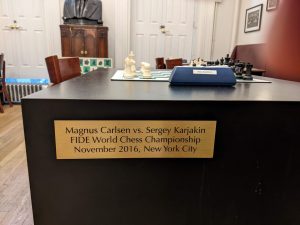
Players for the morning rapid tournament began to arrive about fifteen minutes before its scheduled start. My slim hope of participating in the event vanished when I saw an even dozen players on the entry list. There is no way a non-member like me should bump a dues paying Marshall CC member from any club event. Those membership dues run from $175 to $325 depending on your address, age, and USCF title. I introduced myself to several of the players and told them I was visiting from North Carolina. At least two of them had heard of us! GM Daniel Naroditsky was recently named chess columnist for the New York Times. They were aware of his association with our Charlotte Chess Center.
The competitors were really nice to me and would have loved to have me participate in the tournament even though ‘I am a non member’. The group included two middle/elementary school entrants and only one player over forty. The rest I estimated to be in the eighteen to thirty age range. Two of the guys told me they had learned the game during the Covid isolation by playing online. Now they were stepping up to over-the-board chess.
The tournament was directed by the ‘doorkeeper’ and another twentyish young man. One of them gave a quick, rehearsed, run down of the tournament rules and quickly disappeared into one of the several rooms just off the upstairs hall. Apparently, my presence went unnoticed. Although the tournament was for players U2000, the twelve players all had ratings under USCF 1600. I watched several boards during the first round. My impression was that the play was pretty sound for U1600 players in a G/25 time control. Mistakes were there but no ‘I lost my queen’ blunders. The second round also produced some interesting games including a near miraculous comeback win under time pressure for the eventual tournament winner. My last hope of getting a rated game was to have a withdrawal in the final round. No TD wants a paying player to sit out a game and I was ready to fill in. I never got that chance because the ‘doorkeeper’ finally recognized me and asked me to leave because ‘you are a non member’. I thanked him for the opportunity to visit and left the upstairs hall. I had to return to ask him to let me out of the always-locked front door.
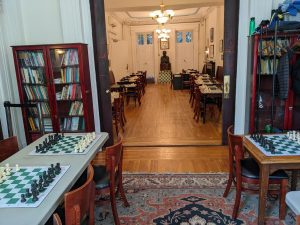
What would I recommend for a player planning to visit the Marshall CC? First of all, I would advise going to the club website for information about events, hours, and restrictions. There are some tournaments at the Marshall CC that allow non-members to participate. Their Covid restrictions may change for members and guests. I had to show my vaccination card to enter. Having a Marshall member accompany you might be the best way to get in to play some casual games. Although there was no casual chess during my morning visit, I am sure there are plenty of games to be had during the afternoon and evening hours. If all else fails, pretend to be a journalist. It worked for me!
_________________________________________________________________________________
President’s Perspective
Growing The Chess Population – by Charles Roberson
I am very happy to see the return of OTB events in the past year and that attendance records were set in almost every open event. Nation wide the USCF participation numbers are interesting. If I recall the pre-COVID numbers correctly, the current scholastic participation levels are down 20% however the adult participation levels are up over 10%. These participation levels are reflected in NC events. Participation in the NC scholastics and the NC girls championships is down considerably, but the open events are setting records which shows adults are coming back faster than kids. Also, the 10%+ increase in adult participation shows we are getting completely new adults entering tournament chess. The last ALTO event had participation levels considerably above normal ( including a significant number of new unrated entries) and this year the Carolina Classic set a new NC record of 399 entries. That is an NC record for any open tournament. This is really important because I believe there exist a large number of untapped adults ready to enter the real chess world. Also, I believe there exist a large number of player that have “retired” from chess that could be coerced into coming back.
I believe there are lots of untapped chess players in the state. A decade ago, FIDE commissioned a marketing firm to find out how many people in the world play chess. Some rounded national averages were reported in an article on chessbase.com. Note that some countries were above these averages some below.
- One in 10 know how to play chess: that is 780+ million in the world, 33+ million people in the US and 1+ million in NC.
- One in 100 play chess multiple times a year with family and neighbors: that is 78+ million in the world, 3+ million people in the US and 110+ thousand in NC.
- One in 1,000 play chess at a club: that is 7.8+ million in the world, 330+ thousand people in the US and 11+ thousand in NC.
- One in 10,000 compete in chess tournaments: that is 780+ thousand in the world, 33+ thousand people in the US and 1,100+ in NC.
Are these numbers outdated (10+ years old and pre COVID shutdowns)? Are the US numbers higher than world averages? A new AGON report from early 2020 discussed on chess.com ( How Popular Is Chess? ) and dated March 9 2020 (preCOVID shutdown and months prior to the release of “The Queen’s Gambit”) states:
- “70% of US adults have played chess at some point in their lives”
- “35 million play chess regularly”
- “Over half are 18 to 34 years of age”
Consider the online chess server numbers. During COVID all servers claimed an increase of 2x in users. Another increase of 2x came after “The Queen’s Gambit” aired. In the article Inside Chess.com’s smart move to Google Cloud , dated July 20, 2021, states:
- “But in March 2020 alone, our number of daily active users rose from 280,000 to more than 1 million.”
- “And then, after The Queen’s Gambit debuted on Netflix last November, it doubled again. “
- “At the peak, we were serving up to 6 million users each day. “
- “After The Queen’s Gambit, our site traffic stabilized to around 4 million daily active users.”
In 2019, chess.com claimed 20+ million users. Now, they claim 77+ million users. So, not only did the number of users increase, the number of times a person played online per month increased. Seventy-seven million is more people than the marketing firm claimed played chess against family and friends regularly a decade ago. Since the online play experience is closer to club play than playing friends and family (it has a clock and multiple ratings for multiple time controls) we should consider that the number of potential club members has increased by 4x.
So, where do we stand relative to those numbers? The USCF active member numbers are 48,586 and 1,726 for the nation and NC respectively. Active chess players are those that have participated in a tournament in the last 12 months. The US is clearly over decade old world national averages, but those world averages are clearly outdated. Given the number of people playing online chess has increased by 4x, we should expect there are at least 7,000 potential tournament players in NC. Thus, clubs could considerably increase their memberships. The potentials exist now! It is time to advertise!
What are the new dynamics?
- We need to focus on everybody not just kids.
- Post COVID numbers have proven that there are non chess playing adults that will learn to play chess then become club members and tournament competitors.
- Adults are coming back faster than the juniors.
- 30 years of pushing scholastic recruitment has resulted in good and bad: many adults left chess tournaments due to rating issues during the massive increase in kids participating. The USCF didn’t make a major upgrade to the rating system until 2015. The old system from the 1990s was deflationary not inflationary. The new system has fixed the deflation issue. This needs advertising to the adults that left due to rating issues.
- Some adults (even a NM) told me they no longer have the patience for long TC tournaments. Back in the 1980’s, there were only regular rated tournaments and one rating.
- Many don’t know that the USCF tracks 6 independent ratings for members: OTB – regular, quick, blitz and Online – regular, quick and blitz.
- Some people have told me they don’t like online play affecting their OTB ratings. This doesn’t happen.
- Some think adults are too old to learn chess. This is not true. There has been published research showing that seniors can still learn and that learning (no matter the age) is 3x more effective when it is fun.
- Some think you can’t get new adults into chess. This is clearly not true. The hit Netflix series “The Queen’s Gambit” has brought huge numbers of new people to “casual” chess. Also, we have seen record numbers of unrated adults entering big tournaments. The last ALTO tournament had about 10% unrated participants.
What can we do?
- Advertise the advantages or adults playing chess and old people playing chess.
- Chess is better for your mind than bridge: research shows that games that allow look ahead calculation (full information games like chess) produce more brain benefits than card games.
- Chess makes mental math fun. I’ve seen many people get better at mental math quickly due to chess.
- Blind people can play chess.
- Some people with Autism enjoy chess a lot.
- We should advertise outside the chess clubs and outside the USCF to the non club member masses. You should advertise ncchess.org to people. It is an easy url to remember and it will teach people a lot about chess in NC. Also, you can help advertise ncchess.org by getting a bumper sticker that says ncCHESS.org on it. We have them free to anybody that will put them on their vehicle.
- Chess clubs need to be in the public eye
- Meet in public places
- Wear you chess shirts in public: Club shirts and tournament shirts get attention. Also, wear any kind of chess shirt.
Clubs that meet in public places are self advertising. The Burlington club used to meet at a market and now at an ice cream shop. This mutually beneficial to us and the business: we bring them business and their customers accidentally see us and start spectating, asking questions, playing and joining. Raleigh has a club that meets on Sundays outside at a public location and is doing well.
-
- “Fishing” expeditions
While the Greensboro chess club meets at a community center, on some Friday nights they meet at a public place. The Burlington club has set up tables at Maker Fair’s and other public events. It is a great way to get new people in.
-
- Newspaper articles
I’ve found that local newspapers will publish the results of tournaments if somebody local wins or does well. So, they should publish a report on an in club tournament. We’ve had several articles in the paper over the last 10 years. The only ones that get us new visitors are the ones with pictures. The ones without pictures haven’t generated new interest.
-
- Web pages – Facebook, Google sites
Every club needs web pages. These can be done for free via Facebook or Google sites. I prefer something on Google sites because they allow you to create a web site for free that is more elaborate than Facebook pages. I use both. Facebook is good for a club blog of events.
-
- YouTube
YouTube is a neat way to get noticed and a way to increase the interest level of many existing club members. You play your nemesis and watch the blitz game on YouTube. The Burlington club posted video’s on a YouTube channel but it didn’t take off until we created our own channel under our name (Burlington Chess Club). Make sure Chess is in the name of your channel.
-
- Twitch
Twitch can be a way to advertize your club. Try streaming a continuous feed of your top board/players during a club meeting.
-
- Online TLA
If you run tournaments, the USCF now has a free online TLA. Fill out the questions and it creates a web page for you then sends email to USCF members advertising it.
- School chess clubs that aren’t involved in tournament chess: big hurdles for new players and parents, small fish in tiny ponds – attract them to a bigger pond.
I’ve met several teachers that run school clubs from elementary to High School that knew nothing about the USCF, tournaments or anything involving real chess. I’ve worked with them to teach the kids, but when I discuss getting involved in the bigger chess scene they say the same things “My kids aren’t that good”, “I don’t know how to do that”, “that would require lots of organization”, “I’d have to get the parent’s involved”…. These people need a way to gradually get involved in the bigger scene that has smaller hurdles. My first thought was an weekly online match between various school teams. It would take place after school with the school’s equipment. Many of the teams could be the new teams as well as the teams that are heavily involved in NC chess and the USCF. This could grow NC scholastic.
_________________________________________________________________________________
To Move and Win!
By John Timmel
The Match of the Century between Bobby Fischer
and Boris Spassky began July 11, 1972, 50 years ago!
The following position from game one is possibly the most recognized in World Championship history.
Fischer, Robert
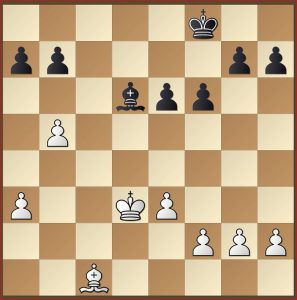
Spassky, Boris
In a balanced position Fischer played 29….Bxh2 and went on to lose.
Bobby overlooked that after 30 P-N3 P-KR4 31 K-K2 P-R5 32 K-B3 P-R6 33 K-N4 B-N8 34 KxP BxP White cuts off the escape of Black’s Bishop by playing 35 B-Q2.
The ensuing position shows how difficult the game was.

black just played 37….Ke4 (?? per Pachmann)
White to move and win (and what should black have played instead of 37….Kd5-e4)
If you have trouble solving without use of an engine, you’re not alone.
It confounded the world’s best.
2022 Candidates tournament
Round one saw Ian Nepomniachtchi defeating a top rival in convincing fashion.
He would go on to easily win the tournament undefeated with 9.5/14
and will face Magnus Carlsen in a second World Championship match. **
Nepomniachtchi, Ian
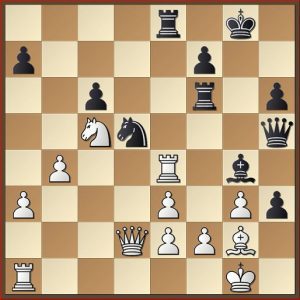
Ding Liren
White has just taken the black pawn with 28. Rxe4, threatening Rxe8 check.
Black to Move and win
Radjabov, Teimour
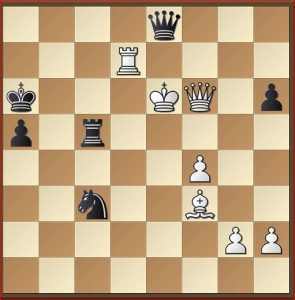
Caruana, Fabio
White to move and win
Radjabov, Teimour
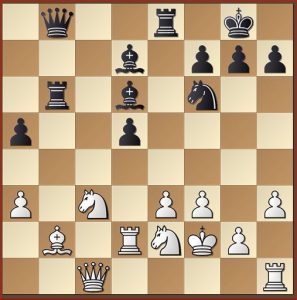
Ding Liren
Black to move and win.